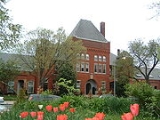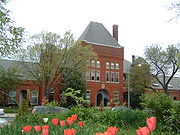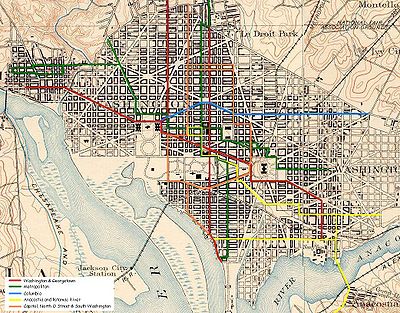
Metropolitan Railroad
Encyclopedia

Washington Railway and Electric Company
The Washington Railway and Electric Company was the larger of the two major street railway companies in Washington, D.C., the capital of the United States, until 1933. At that time, it was merged with its main competitor, the Capital Traction Company, to form the Capital Transit Company...
.
Origins

Washington and Georgetown Railroad
The Washington and Georgetown Railroad Company was the first streetcar company to operate in Washington, D.C. It was incorporated and started operations in 1862, running from Georgetown to the Navy Yard. Two additional lines ran on 7th Street NW/SW and 14th Street NW. In 1890 it switched from...
Company. It opened two lines. One from the Capitol to the War Department
United States Department of War
The United States Department of War, also called the War Department , was the United States Cabinet department originally responsible for the operation and maintenance of the United States Army...
at 14th and I Streets NW and a second along H Street
H Street (Washington, D.C.)
H Street is an east-west street in Washington, D.C.. It is also used as an alternate name for the Near Northeast neighborhood, as H Street is the neighborhood's main commercial strip.-History:...
NW from Massachusetts Avenue
Massachusetts Avenue (Washington, D.C.)
Massachusetts Avenue is a major diagonal transverse road in Washington, D.C., and the Massachusetts Avenue Historic District is a historic district that includes part of it....
NW to 17th Street NW. When it started, it used two-horse cars, but in 1865 it switched to smaller cars pulled by one horse.
Expansion
In 1872, it began operations on a 9th Street line with a terminus on M Street NW. In that same year it bought the Union Railroad Company. The Union, chartered on January 19, 1872, was to lay track from the Treasury Building at 15th Street and New York Avenue NW to Georgetown across the P Street Bridge and then on various streets in Georgetown. The Metropolitan used the Union's charter to build a line into Georgetown.The Boundary and Silver Spring Railway Company was purchased by the Metropolitan in 1873. The Boundary and Silver Spring, also chartered on January 19, 1872, was to run a streetcar from Boundary Street NW to the Maryland-D.C. boundary along the Washington City and Rockville Turnpike (now Georgia Avenue NW). Again, the Metropolitan only purchased a charter and used it to run streetcars along Georgia Avenue all the way to Rock Creek Church Road NW.
In 1874, the Metropolitan acquired the Connecticut Avenue and Park Railway. The Connecticut Avenue and Park was chartered on July 13, 1868. This line started at the terminus of the Metropolitan at 17th and H Streets NW and ran north up Connecticut Avenue
Connecticut Avenue (Washington, D.C.)
Connecticut Avenue is a major thoroughfare in the Northwest quadrant of Washington, D.C., and suburban Montgomery County, Maryland. It is one of the diagonal avenues radiating from the White House, and the segment south of Florida Avenue was one of the original streets in Pierre Charles...
NW to Boundary Street NW. The streetcar line did not continue up Connecticut Avenue NW from this point because the grade was too steep for the horse-drawn cars. Operation of this line began in April 1873. Though tracks were laid on Connecticut Avenue NW north of P Street NW, cars did not run on this portion until 1883 when local residents petitioned Metropolitan to begin a shuttle service.
By 1888 the Metropolitan had built additional lines down 4th Street NW/SW to the Arsenal at P Street SW and on East Capitol Street
East Capitol Street
East Capitol Street is a major street that divides the northeast and southeast quadrants of Washington, D.C. It runs due east from the United States Capitol to the DC-Maryland border. The street is uninterrupted until Lincoln Park then continues eastward to Robert F. Kennedy Memorial Stadium...
to 9th Street.
Switch to Electricity
The old Boundary and Silver Spring line on Seventh Street Extended NW - a.k.a. Brightwood Avenue NW (now known as Georgia Avenue NWGeorgia Avenue
Georgia Avenue is a major north-south artery in Northwest Washington, D.C. and Montgomery County, Maryland. Within the District of Columbia and a short distance in Silver Spring, Maryland, Georgia Avenue is also U.S. Route 29...
) - was never profitable. On October 18, 1888, the day after electric streetcar operations began in Washington, Congress authorized the Brightwood Railway Company to purchase and electrify the Metropolitan's streetcar line and to extend it to the District boundary at Silver Spring
Silver Spring, Maryland
Silver Spring is an unincorporated area and census-designated place in Montgomery County, Maryland, United States. It had a population of 71,452 at the 2010 census, making it the fourth most populous place in Maryland, after Baltimore, Columbia, and Germantown.The urbanized, oldest, and...
. In 1890 the Metropolitan sold the line to the upstart company.
In 1890, while the city's streetcars switched to electric and mechanical power, the Metropolitan experimented with batteries but found them unsatisfactory. On August 2, 1894 Congress ordered the Metropolitan to switch to underground electrical power. It complied, installing the underground sliding shoe on the north-south line in January 1895. It was the first successful installation of such a system in the Western Hemisphere
Western Hemisphere
The Western Hemisphere or western hemisphere is mainly used as a geographical term for the half of the Earth that lies west of the Prime Meridian and east of the Antimeridian , the other half being called the Eastern Hemisphere.In this sense, the western hemisphere consists of the western portions...
(having previously been installed in Budapest, Hungary). Though mostly a success, the underground power conduits had drawbacks. In the winter, the plow would get jammed by snow
Snow
Snow is a form of precipitation within the Earth's atmosphere in the form of crystalline water ice, consisting of a multitude of snowflakes that fall from clouds. Since snow is composed of small ice particles, it is a granular material. It has an open and therefore soft structure, unless packed by...
and ice
Ice
Ice is water frozen into the solid state. Usually ice is the phase known as ice Ih, which is the most abundant of the varying solid phases on the Earth's surface. It can appear transparent or opaque bluish-white color, depending on the presence of impurities or air inclusions...
and in the summer the conduits swelled shut.
The Metropolitan switched the rest of the system to electric power on July 7, 1896. The new system required new construction in and in 1895, Metropolitan built a massive, Romanesque
Romanesque architecture
Romanesque architecture is an architectural style of Medieval Europe characterised by semi-circular arches. There is no consensus for the beginning date of the Romanesque architecture, with proposals ranging from the 6th to the 10th century. It developed in the 12th century into the Gothic style,...
style car barn on the corner of 4th Street SW and P Street SW. In the same year, Metropolitan built a loop on 35th Street NW and 36th Street NW to Prospect Street NW to connect it to the Georgetown Car Barn. In 1896 it extended service along East Capitol Street to 15th Street and built the East Capitol Street Car Barn, a Romanesque Revival style building designed by Waddy Wood, to serve as a barn, repair shop, and administrative office
Office
An office is generally a room or other area in which people work, but may also denote a position within an organization with specific duties attached to it ; the latter is in fact an earlier usage, office as place originally referring to the location of one's duty. When used as an adjective, the...
s ( photo); In the same year the company extended its service along Columbia Road NW and Mount Pleasant Street NW as far as Park Road NW.
Metropolitan Coach Company
After the Herdic Phaeton CompanyHerdic Phaeton Company
The Herdic Phaeton Company was a late 19th Century horse drawn stagecoach company in Washington, D.C. It started operations in December 1879, taking over for a horse drawn chariot company that had operated unsuccessfully for three years. The company took its name from the chariot's designer Peter...
went under in 1896, the Metropolitan Railroad started a coach company running horse drawn coaches
Stagecoach
A stagecoach is a type of covered wagon for passengers and goods, strongly sprung and drawn by four horses, usually four-in-hand. Widely used before the introduction of railway transport, it made regular trips between stages or stations, which were places of rest provided for stagecoach travelers...
. It began carrying passengers from 16th
16th Street Northwest (Washington, D.C.)
16th Street Northwest is a prominent north-south thoroughfare in the northwest quadrant of Washington, D.C.Part of Pierre L'Enfant's design for the city, 16th Street begins just north of the White House across Lafayette Park at H Street and continues due north in a straight line passing K Street,...
and T Streets NW to 22nd and G Streets NW, but the route changed, later running from 16th and U Streets NW to the Treasury Building and then along Pennsylvania Avenue NW to 9th Street NW. It began operations on May 1, 1897 with a car barn at 1914 E Street NW. In 1904 it became its own corporation
Corporation
A corporation is created under the laws of a state as a separate legal entity that has privileges and liabilities that are distinct from those of its members. There are many different forms of corporations, most of which are used to conduct business. Early corporations were established by charter...
.
The End of the Line

Holding company
A holding company is a company or firm that owns other companies' outstanding stock. It usually refers to a company which does not produce goods or services itself; rather, its purpose is to own shares of other companies. Holding companies allow the reduction of risk for the owners and can allow...
for these interests. But the holding company had borrowed too heavily and paid too much for the subsidiaries and was quickly in financial trouble. Because of this, Congress - on June 5, 1900 - authorized the Washington and Great Falls to acquire the stock of any and all of the railways and power companies
Electrical power industry
The electric power industry provides the production and delivery of electric energy, often known as power, or electricity, in sufficient quantities to areas that need electricity through a grid connection. The grid distributes electrical energy to customers...
owned by Washington Traction. When Washington Traction defaulted
Default (finance)
In finance, default occurs when a debtor has not met his or her legal obligations according to the debt contract, e.g. has not made a scheduled payment, or has violated a loan covenant of the debt contract. A default is the failure to pay back a loan. Default may occur if the debtor is either...
on its loans on June 1, 1901 Washington and Great Falls moved in to take its place. On February 4, 1902, Washington and Great Falls changed its named to the Washington Railway and Electric Company
Washington Railway and Electric Company
The Washington Railway and Electric Company was the larger of the two major street railway companies in Washington, D.C., the capital of the United States, until 1933. At that time, it was merged with its main competitor, the Capital Traction Company, to form the Capital Transit Company...
, reincorporated as a holding company and exchanged stock in Washington Traction and Electric one for one for stock in the new company (at a discounted rate). This was the end of the Metropolitan Railroad Company.

